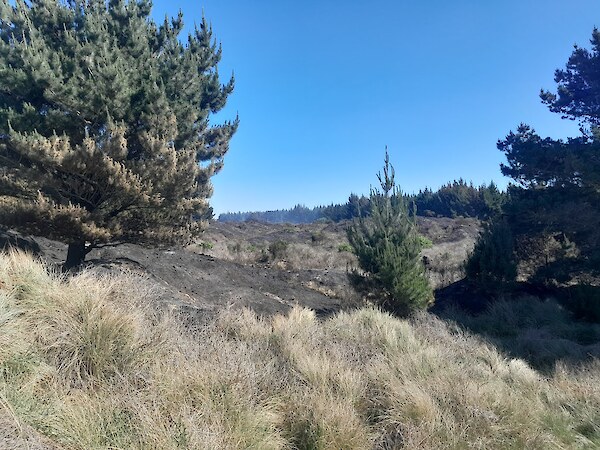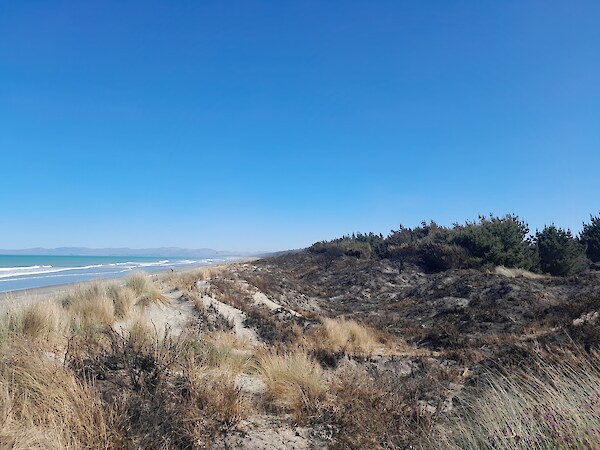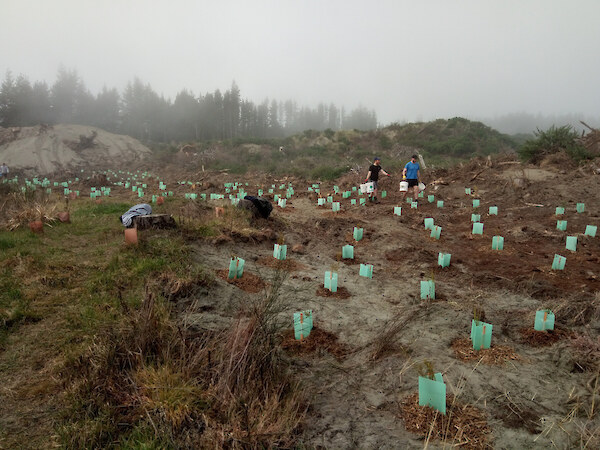This project has been plagued by delays due to Covid, weather and, most recently, a fire. However, the team is optimistic and replanting soon. See this article on RNZ.
News November 2022
 Fire damage in Tūhaitara Coastal Park, North Canterbury
Fire damage in Tūhaitara Coastal Park, North Canterbury
As has been widely reported in the national news, fire swept through more than 200 hectares of coastal pine forest in the Tūhaitara Coastal Park in North Canterbury in early November 2022. This is the site of one of the Coastal Restoration Trust’s planting trials in collaboration with Te Kōhaka o Tūhaitara Trust. It is understood that the fire was started by fireworks at the northern end of the park and travelled south along the coastal dunes fanned by winds in the direction of Woodend Beach.
It has burnt extensive areas of both the protective pine and marram grass dominated frontal dunes and the plantation forests on the backdunes. At one point the campground at Woodend Beach had to be evacuated as helicopters with monsoon buckets and ground based fire crews worked to bring the blaze under control.
 Greg Byrnes, General Manager of Te Kōhaka o Tūhaitara Trust (TKOT), has appreciated the support from the Coastal Restoration Trust and has indicated that “…while it has been a significant event, we have a number of opportunities from the fire. One being that many of our biota node native plantings have come through relatively unscathed. Similarly, at Tūtaepatu Lagoon, while initial views look pretty bad, the tī kōuka, harakeke and aruhe fern will all come back quickly.”
Greg Byrnes, General Manager of Te Kōhaka o Tūhaitara Trust (TKOT), has appreciated the support from the Coastal Restoration Trust and has indicated that “…while it has been a significant event, we have a number of opportunities from the fire. One being that many of our biota node native plantings have come through relatively unscathed. Similarly, at Tūtaepatu Lagoon, while initial views look pretty bad, the tī kōuka, harakeke and aruhe fern will all come back quickly.”
“The only infrastructure we have lost is the lower lookout at Tūtaepatu and around twenty bollards, so this too is not as bad as it could have been. In short, lots of positives, natives resilience over pines, main trails acting as fire breaks, and biota nodes offering seed islands.”
The 3-year coastal sequence planting project, funded by the Department of Conservation’s Community Fund, is aimed at setting up a demonstration site of a restored native coastal forest sequence that was typical of north Canterbury. This project adds and complements the restoration work already underway by TKOT with a multi-generational vision to restore indigenous coastal ecosystems supporting a diverse range of native flora and fauna species and providing sustainable mahinga kai. The project involves replacing logged pines and marginal pasture with foredunes of sandbinders, mid-zone coastal shrublands, wetlands and lagoons, and landward coastal podocarp forest.
COVID-19 lockdown restrictions had postponed earlier plantings particularly where community planting days had to be postponed or cancelled, then flooding in mid-2022 delaying this year’s planting, and now the fire has likely set back progress further.
Greg and his team at TKOT are already working on an action plan which will be ready by the end of the month. The Coastal Restoration Trust will inspect the dune sequence planting trials early in December 2022 where we expect to see many of the first two years of plantings damaged as these sites were in the direct path of the fire. However, we are already collaborating with Greg and with Trees That Count to provide support for new plantings next season.
David Bergin
Trustee, Coastal Restoration Trust of NZ
Update March 2021
Despite several months delay to planning due to Covid-19 Lockdown a planning day was undertaken in June 2020 at the Te Kōhaka o Tūhaitara (TKOT) Rangers Station, Tūhaitara Coastal Park with project partners including TKOT, Waimakariri Council, Coastal Restoration Trust and the DOC contract relationship manager. This included inspection of sites from foredunes to landward and selection of planting areas for demonstration and discussion of site and planting treatments.
A workplan and a report on soil characteristics and topography of the transect was completed.
 TKOT have completed Year 1 site preparation of part of the coastal sequence site. The first community planting day for this project was undertaken with 100 from the Student Volunteer Army planting over 1000 native trees in August and a further community planting day undertaken in September.
TKOT have completed Year 1 site preparation of part of the coastal sequence site. The first community planting day for this project was undertaken with 100 from the Student Volunteer Army planting over 1000 native trees in August and a further community planting day undertaken in September.
A network of monitoring plots was established to sample across planted sites. Established biota nodes are also being monitored as part of the project to give up to 10 years of growth data on the range of native trees and shrubs planted.
Planning is well underway for the second planting season with a minimum of 5000 native trees, shrubs and sand binding plants within the coastal sequence zone from foredunes to backdunes. The next community planting day is planned for June and further monitoring plots will be established.
Other work has involved the gradual replacement of willows and underplanting with natives, specifically kahikatea to restore the lagoon with indigenous vegetation that supports mahinga kai and spiritual values.
In February 2020 the Trust signed a funding agreement with DOC under their Community Fund, to restore a native forest coastal sequence in Tūhaitara Coastal Park, North Canterbury. Here is a
Summary of the project
OBJECTIVES
- Te Kōhaka o Tūhaitara Trust and Coastal Restoration Trust will set up a demonstration site of a restored native coastal forest sequence that was typical of north Canterbury.
- This 3-year project adds and complements the restoration work already underway by Te Kōhaka o Tūhaitara Trust and their multi-generational vision to restore indigenous coastal ecosystems supporting a diverse range of native flora and fauna species and providing sustainable mahinga kai.
- This involves replacing logged pines and marginal pasture with foredunes of sandbinders, mid-zone coastal shrublands, wetlands and lagoons, and landward coastal podocarp forest.
- A complete coastal vegetation sequence dominated by indigenous flora and fauna will be more resilient to expected impacts of climate change and provide an excellent demonstration area for other coastal communities and landowners in Canterbury and nationwide.
METHODS
- We propose planting and managing a minimum 50 m wide demonstration coastal vegetation sequence linking existing small restoration areas within a high-profile part of the park.
- This builds on the restoration work already underway by Te Kohaka o Tuhaitara including the Tutaepatu Lagoon plantings, the network of biota nodes set up by local schools and community groups, the Pines Beach wetland restoration, planting of sand dunes recently logged of pines with natives, and restoring extensive areas of recently retired pasture.
- A minimum of 5000 native trees, shrubs, ground cover coastal and wetland species will be planted per year across the coastal sequence in collaboration with community volunteers, school and tertiary students, and local service groups.
- Monitoring will involve setting up a series of survival and growth plots on landward sites and point sampling transects on mid and foredune sites in collaboration with volunteer community groups wherever possible supervised by Te Kohako o Tuhaitara and the Coastal Restoration Trust.
- Vegetation monitoring will be integrated wherever possible with monitoring of fauna undertaken in the park including changes in insect, lizard, bird and fish diversity and populations over time.
- Outputs to include guidelines on essential steps to successful restoration of a coastal flora sequence for north Canterbury and recommendations for other coastal sites nationwide.
COLLABORATION
- Collaborating partners include Environment Canterbury, University of Canterbury, Trees That Count, Tāne’s Tree Trust, Waimakariri District Council, and numerous local community and resident associations, service groups, schools, and environmental NGOs.
